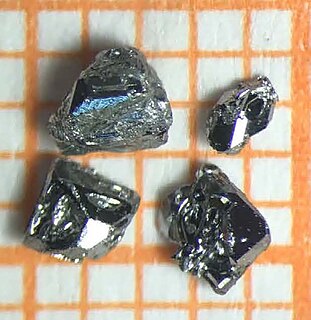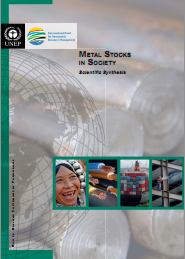Related Research Articles

An alloy is a combination of a metal and one or more other elements. For example, combining the metallic elements gold and copper produces red gold, gold and silver becomes white gold, and silver combined with copper produces sterling silver. Elemental iron, combined with non-metallic carbon or silicon, produces alloys called steel or silicon steel. The resulting mixture forms a substance with properties that often differ from those of the pure metals, such as increased strength or hardness. Unlike other substances that may contain metallic bases but do not behave as metals, such as aluminium oxide (sapphire), beryllium aluminium silicate (emerald) or sodium chloride (salt), an alloy will retain all the properties of a metal in the resulting material, such as electrical conductivity, ductility, opaqueness, and luster. Alloys are used in a wide variety of applications, from the steel alloys, used in everything from buildings to automobiles to surgical tools, to exotic titanium-alloys used in the aerospace industry, to beryllium-copper alloys for non-sparking tools. In some cases, a combination of metals may reduce the overall cost of the material while preserving important properties. In other cases, the combination of metals imparts synergistic properties to the constituent metal elements such as corrosion resistance or mechanical strength. Examples of alloys are steel, solder, brass, pewter, duralumin, bronze and amalgams.

Bronze is an alloy consisting primarily of copper, commonly with about 12–12.5% tin and often with the addition of other metals and sometimes non-metals or metalloids such as arsenic, phosphorus or silicon. These additions produce a range of alloys that may be harder than copper alone, or have other useful properties, such as stiffness, ductility, or machinability.

A metal is a material that, when freshly prepared, polished, or fractured, shows a lustrous appearance, and conducts electricity and heat relatively well. Metals are typically malleable or ductile. A metal may be a chemical element such as iron; an alloy such as stainless steel; or a molecular compound such as polymeric sulfur nitride.
A period 4 element is one of the chemical elements in the fourth row of the periodic table of the elements. The periodic table is laid out in rows to illustrate recurring (periodic) trends in the chemical behaviour of the elements as their atomic number increases: a new row is begun when chemical behaviour begins to repeat, meaning that elements with similar behaviour fall into the same vertical columns. The fourth period contains 18 elements beginning with potassium and ending with krypton – one element for each of the eighteen groups. It sees the first appearance of d-block in the table.

Brazing is a metal-joining process in which two or more metal items are joined together by melting and flowing a filler metal into the joint, the filler metal having a lower melting point than the adjoining metal.
A base metal is a common and inexpensive metal, as opposed to a precious metal such as gold or silver. A long-time goal of alchemists was the transmutation of a base metal into a precious metal. In numismatics, coins often derived their value from the precious metal content; however, base metals have also been used in coins in the past and today.
Plating is a surface covering in which a metal is deposited on a conductive surface. Plating has been done for hundreds of years; it is also critical for modern technology. Plating is used to decorate objects, for corrosion inhibition, to improve solderability, to harden, to improve wearability, to reduce friction, to improve paint adhesion, to alter conductivity, to improve IR reflectivity, for radiation shielding, and for other purposes. Jewelry typically uses plating to give a silver or gold finish.

An intermetallic is a type of metallic alloy that forms a solid-state compound exhibiting defined stoichiometry and ordered crystal structure.
The galvanic series determines the nobility of metals and semi-metals. When two metals are submerged in an electrolyte, while also electrically connected by some external conductor, the less noble (base) will experience galvanic corrosion. The rate of corrosion is determined by the electrolyte, the difference in nobility, and the relative areas of the anode and cathode exposed to the electrolyte. The difference can be measured as a difference in voltage potential: the less noble metal is the one with a lower electrode potential than the nobler one, and will function as the anode within the electrolyte device functioning as described above. Galvanic reaction is the principle upon which batteries are based.
Ferroalloy refers to various alloys of iron with a high proportion of one or more other elements such as manganese (Mn), aluminium (Al), or silicon (Si). They are used in the production of steels and alloys. The alloys impart distinctive qualities to steel and cast iron or serve important functions during production and are, therefore, closely associated with the iron and steel industry, the leading consumer of ferroalloys. The leading producers of ferroalloys in 2014 were China, South Africa, India, Russia and Kazakhstan, which accounted for 84% of the world production. World production of ferroalloys was estimated as 52.8 million tonnes in 2015.

Alloy steel is steel that is alloyed with a variety of elements in total amounts between 1.0% and 50% by weight to improve its mechanical properties. Alloy steels are broken down into two groups: low alloy steels and high alloy steels. The difference between the two is disputed. Smith and Hashemi define the difference at 4.0%, while Degarmo, et al., define it at 8.0%. Most commonly, the phrase "alloy steel" refers to low-alloy steels.

A native metal is any metal that is found pure in its metallic form in nature. Metals that can be found as native deposits singly or in alloys include aluminium, antimony, arsenic, bismuth, cadmium, chromium, cobalt, indium, iron, manganese, molybdenum, nickel, niobium, rhenium, selenium, tantalum, tellurium, tin, titanium, tungsten, vanadium, and zinc, as well as two groups of metals: the gold group, and the platinum group. The gold group consists of gold, copper, lead, aluminium, mercury, and silver. The platinum group consists of platinum, iridium, osmium, palladium, rhodium, and ruthenium. Amongst the alloys found in native state have been brass, bronze, pewter, German silver, osmiridium, electrum, white gold, and silver-mercury and gold-mercury amalgam.

Glass-to-metal seals are a very important element of the construction of vacuum tubes, electric discharge tubes, incandescent light bulbs, glass encapsulated semiconductor diodes, reed switches, pressure tight glass windows in metal cases, and metal or ceramic packages of electronic components.
The coinage metals comprise, at a minimum, those metallic chemical elements which have historically been used as components in alloys used to mint coins. The term is not perfectly defined, however, since a number of metals have been used to make "demonstration coins" which have never been used to make monetized coins for any nation-state, but could be. Some of these elements would make excellent coins in theory, but their status as coin metals is not clear. In general, because of problems caused when coin metals are intrinsically valuable as commodities, there has been a trend in the 21st century toward use of coinage metals of only the least exotic and expensive types.

Native element minerals are those elements that occur in nature in uncombined form with a distinct mineral structure. The elemental class includes metals and intermetallic elements, naturally occurring alloys, semi-metals and non-metals. The Nickel–Strunz classification system also includes the naturally occurring phosphides, silicides, nitrides and carbides and arsenides.

The report Metal Stocks in Society: Scientific Synthesis was the first of six scientific assessments on global metals to be published by the International Resource Panel (IRP) of the United Nations Environment Programme. The IRP provides independent scientific assessments and expert advice on a variety of areas, including:

Materials for use in vacuum are materials showing very low rate of outgassing in vacuum, and, where applicable, tolerant to the bake-out temperatures. The requirements grow increasingly stringent with the desired degree of vacuum achievable in the vacuum chamber. The materials can produce gas by several mechanisms. Molecules of gases and water can be adsorbed on the material surface. Materials may sublimate in vacuum. Or the gases can be released from porous materials or from cracks and crevices. Traces of lubricants, residues from machining, can be present on the surfaces. A specific risk is outgassing of solvents absorbed in plastics after cleaning.
References
- ↑ Hunter, Christel (2006). Aluminum Building Wire Installation and Terminations, IAEI News, January–February 2006. Richardson, TX: International Association of Electrical Inspectors.
- ↑ Hausner(1965) Beryllium its Metallurgy and Properties, University of California Press
- ↑ "Ultimet® alloy - Nominal Composition". Haynes International . Retrieved October 4, 2016.
- ↑ "Tin Based Alloys". Mayer Alloys.